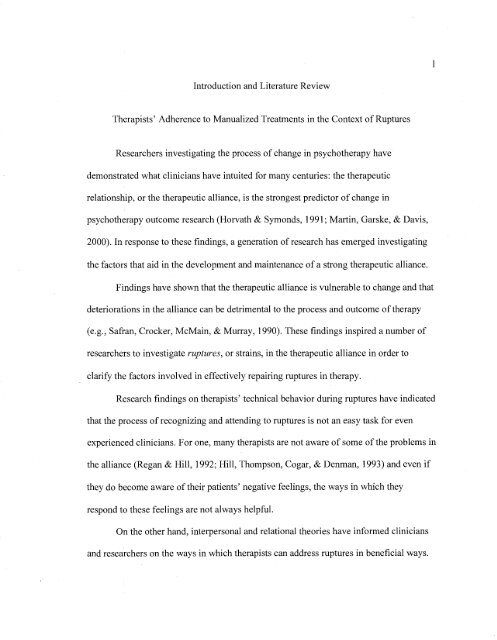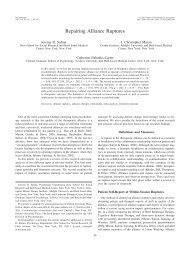Download - The Safran Lab
Download - The Safran Lab
Download - The Safran Lab
You also want an ePaper? Increase the reach of your titles
YUMPU automatically turns print PDFs into web optimized ePapers that Google loves.
Introduction and Literature Review<br />
<strong>The</strong>rapists' Adherence to Manualized Treatments in the Context of Ruptures<br />
Researchers investigating the process of change in psychotherapy have<br />
demonstrated what clinicians have intuited for many centuries: the therapeutic<br />
relationship, or the therapeutic alliance, is the strongest predictor of change in<br />
psychotherapy outcome research (Horvath & Symonds, 1991; Martin, Garske, & Davis,<br />
2000). In response to these findings, a generation of research has emerged investigating<br />
the factors that aid in the development and maintenance of a strong therapeutic alliance.<br />
Findings have shown that the therapeutic alliance is vulnerable to change and that<br />
deteriorations in the alliance can be detrimental to the process and outcome of therapy<br />
(e.g., <strong>Safran</strong>, Crocker, McMain, & Murray, 1990). <strong>The</strong>se findings inspired a number of<br />
researchers to investigate ruptures, or strains, in the therapeutic alliance in order to<br />
clarify the factors involved in effectively repairing ruptures in therapy.<br />
Research findings on therapists' technical behavior during ruptures have indicated<br />
that the process of recognizing and attending to ruptures is not an easy task for even<br />
experienced clinicians. For one, many therapists are not aware of some of the problems in<br />
the alliance (Regan & Hill, 1992; Hill, Thompson, Cogar, & Denman, 1993) and even if<br />
they do become aware of their patients' negative feelings, the ways in which they<br />
respond to these feelings are not always helpful.<br />
On the other hand, interpersonal and relational theories have informed clinicians<br />
and researchers on the ways in which therapists can address ruptures in beneficial ways.<br />
1



